Public Schools as Ethnic Enclaves?
Maura Walz | Jul 30, 2009 | Comments 11
By Maura Walz, with additional reporting and media production by Claire Moses and Joseph C. Lin
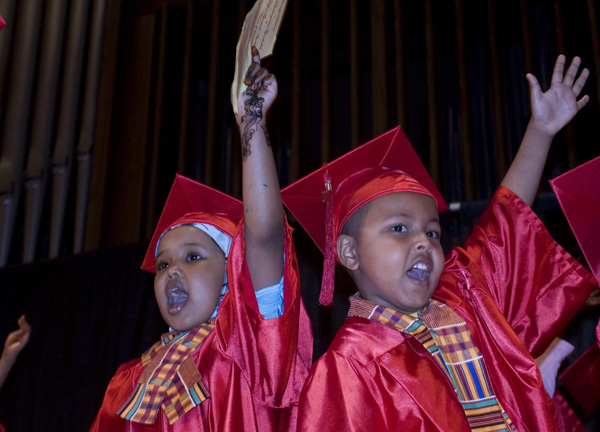
Kindergarten students graduate from Higher Ground Academy, an Afro-centric charter school in St. Paul, Minn. PHOTO: CLAIRE MOSES / NEWS21
Some charter school names in Minnesota’s Twin Cities announce their ethnic preferences straight up.
The Dugsi Academy takes its name from the Somali term for “school.” Academia Cesar Chavez is named after the renowned Chicano labor leader. The Hmong Academy caters to children from the indigenous Cambodian community.
Other schools slide their ethnic identities into their taglines: as in Higher Ground Academy, Minnesota’s Preeminent Afro-Centric Charter School.
There seems to be no end to the ways these hybrid schools have redesigned education for reconfigured populations in this city.
A group of families and members of the Germanic-American Institute in the Twin Cities founded a German language immersion elementary school in 2005. A Chinese language immersion school has attracted many students adopted from China by American families. The East African and Hmong communities — the two largest immigrant groups in Minneapolis and St. Paul — have been especially active in founding culturally-based schools.
And on it goes.
These schools are part of a trend in charter school education toward creating safe havens for niche groups, ones that parents and advocates argue have been neglected by the general school system. Segregate them, they argue, in order to better teach them.
School choice has begun to mean parents choosing a school for children that look just like themselves. As more “ethno-centric” charter schools open, parents and experts are debating the costs and benefits of voluntary racial and ethnic isolation in public schools.
Nearly one-fifth of Minnesota’s more than 150 charter schools cater primarily to families belonging to specific ethnic or cultural groups. By law, any student may attend these schools. But in practice, the majority teach student populations that are overwhelmingly homogeneous.

See how the demographics of charter and traditional public schools in the Twin Cities have changed since 1990.
Hmong students make up 98 percent of the school population in five out of six charters designed just for this burgeoning population in the Twin Cities. Similarly, schools that focus on the Latino or East African immigrant groups, are nearly completely Latino, or East African.
The emergence of these racially isolated schools has left charter school advocates fending off charges that charters are re-segregating the American public school system.
In November, researchers at the University of Minnesota’s Institute on Race and Poverty released a report contending that charter schools have intensified segregation in the Twin Cities. Nearly 90 percent of black charter school students attended a racially segregated school in 2008, the report claimed, compared to just under 40 percent of black students who attended segregated traditional public schools.
“Segregation concentrates poverty, and poor schools perform worse,” said Myron Orfield, director of the Institute on Race and Poverty. “It doesn’t provide any low income minority kids the option to go to better schools.”
But charter school administrators, along with many Minnesota charter parents, say there are important advantages to educating children in culturally sensitive environments. Many of these segregated schools serve recent immigrant children who may be overwhelmed in large traditional schools by language and cultural differences.
Some even contend that words like “segregation” and “integration” are outmoded concepts now that legally mandated racial separation is a thing of the past. Advocates argue that these terms detract from the schools’ significant impact on the wider educational system.
“Segregation is a legal matter,” said Bill Wilson, the founder and executive director of the all-black Higher Ground Academy, an Afro-centric charter school that opened in St. Paul in 1999. Wilson, who went on to become a noted St. Paul civil rights activist and City Council member before founding the school, draws a strong distinction between forcibly segregated schools and racially homogeneous schools that parents and students choose to attend. People who claim his all-black school is only about segregation, he said, cannot overcome the choice issue.
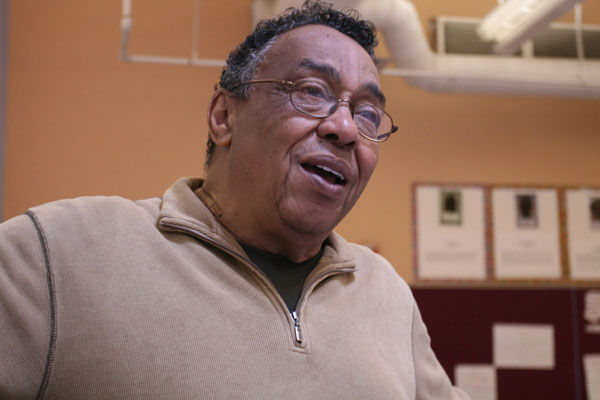
Bill Wilson, founder and executive director of Higher Ground Academy. PHOTO: NEWS21 / CLAIRE MOSES
“I had no choice,” said Wilson about his days as a black student in the racially segregated schools of Indiana. “I rode the bus until the bus stopped and that’s where I got off. Now let’s compare that for a moment with charter schools. It starts with choice.”
Wilson disputed the notion that parents choose these niche schools solely because of race or identity.
“People choose to be here, and they’re not choosing because of the color of their skin,” he said. “They’re really choosing because of the quality of the education.”
Orfield said that the choice charters offer to low-income and minority families is often an illusion. Impoverished families can choose between a dismal traditional public school, he said, or an equally poor-performing or sometimes worse charter school.
“Low-income kids of color don’t have the choice to get into the white segregated schools,” he said. “And white families won’t choose to send their kids to the minority segregated schools.”
The performance of Minnesota charter schools varies widely. Wilson’s Higher Ground Academy does fairly well: just over 53 percent of Higher Ground students were proficient at reading on state accountability tests in 2008, over a percentage point higher than the scores for St. Paul’s traditional public schools, according to the Minnesota Department of Education. In math, Higher Ground students do significantly better, with 52 percent of Higher Ground students scoring proficient, compared to nearly 46 percent of St. Paul school district students.
Higher Ground is not alone. Students at Harvest Prep Academy, another charter school geared towards African-American students, score similarly well. And scores at Tarek Ibn Ziyad Academy, a charter school with a primarily Muslim student body sponsored by Islamic Relief USA that has been the center of much controversy over church-state separation lines, posts among the highest test scores in the region.
It’s unclear to what degree these schools are the exceptions, however. A number of studies of Minnesota charter schools, including a 2008 study by the Minnesota Office of the Legislative Auditor and a 2009 study by Stanford University’s Center for Research on Education Outcomes, have concluded that charter schools largely under-perform compared to their peer traditional public schools.
But some parents said that the quality of the education should be judged by more than just test scores. A school’s ability to embrace students’ cultural identity makes a big difference in their educational life. Ethno-centric charter schools meet student needs in a way that larger traditional public schools cannot manage.
“There’s a lot of social challenges parents are going through,” said Nadifa Osman, a Somali mother who has sent three children to Higher Ground Academy. Large family sizes, parental separation, language challenges and a cultural background where involvement in children’s education is not the norm–all these issues can prevent immigrant parents from engaging in large, traditional public schools.
“When I was growing up, the teacher was in charge of me,” Osman said. “My parents never put one foot inside the school.” Understanding that cultural background, she said, helps the school encourage parents to be more involved, visit the school and talk to the teachers.
Rather than expecting parents to come to the school, Osman said, schools like Higher Ground Academy reach out to parents in the neighborhoods where they live. Osman acts as a parent liaison between the school and Somali families. The school also has parent liaisons to other East African immigrant groups, such as the Oromo community who have fled oppression in Ethiopia. Families that might be lost in a larger public school find a welcoming, supportive environment.
“I came here to help some parents who were struggling,” she said. Osman was raised in Somalia but completed higher education in Europe and the United States. She said that her ability to see both worlds helps her show other Somali parents what it takes for their students to succeed in an American school system.
“It’s very common to say, ‘what you’re going through, I’m going through,’” she said. “That support makes a huge difference.”
Osman said that the opportunity for her children to learn more about their East African heritage and retain their Somali language fluency was also an important factor in choosing the school. But she cautioned that the school is not culturally isolated, with students taught about their own heritage and culture and nothing else.
“They learn more about their heritage and where they’re coming from and the history of the Africans that you don’t get in many mainstream schools,” she said. “But they’re not limited to that. I like that they’re learning about their own culture but open to others as well.”
In Minneapolis and St. Paul, school districts have also responded to market competition from charters that focus on a specific culture by opening their own within the traditional public school systems. The St. Paul public school system, for example, opened the Phalen Lake Hmong Studies and Core Knowledge Magnet School last year. It represents the city’s first magnet program emphasizing one culture.
Critics contend that this response from traditional public schools further intensifies the lines of separation and segregation in the school systems, with harmful result. Many educators in the districts struggle with a commitment to integrated schools and what they say is a clear demand from parents for programs with cohesive cultural identities.
“That’s the conundrum of choice,” said Yusef Mgeni, Director of the Office of Educational Equity for St. Paul Public Schools. “You have to be prepared to modify and adapt your policies to whatever choices parents want to make. The real hat trick is to how to get the best education for everyone under the circumstances people choose.”
The public school system in St. Paul has long striven to provide options for students to take select language, history and culture courses that reflect the diverse make-up of the school district, and district-wide school choice was originally instituted as a mechanism for integration, Mgeni said. And because of a continued trend of falling birthrates and enrollments, he said, a school district would be foolish to ignore the expressed wishes of parents.
Paradoxically, a byzantine system of choice among neighborhood schools, magnet schools, charter schools and others may increase the concentration of single-ethnicity schools because parents may choose the schools most familiar to their communities because the plethora of other choices is overwhelming to research.
“It’s a very complex issue and process for any parent,” Mgeni said. “If you’re a new immigrant, it could seem very daunting.”
Education policy experts confirm that when parents are deciding where to send their children, the desire for cultural sensitivity often outweighs a given school’s academic test scores.
“Those are factors that go to social climate, size and safety of the schools,” said David Garcia, who studies education policy at Arizona State University. “All of those elements make a really big difference in the decisions that individual students and families make and are generally left out of our macro-policy discussions.”
It’s a national pattern, Garcia said. When a student leaves the traditional public school system for a charter, students of every ethnicity, except Latinos, go to schools with a higher concentration of their own ethnic group than the traditional school they left.
But like Minnesota charter advocates, Garcia emphasized that patterns of segregation are the result of an increased mobility that low-income, minority and immigrant families are experiencing for the first time.
“Charter schools have opened up choice to a whole strata of people who’ve never had it before,” he said. “What they do with that choice is really interesting.”
Bill Wilson of St. Paul’s Higher Ground Academy said that too much emphasis on whether or not schools are integrated misses the point.
“At the end of the day, the question remains, is learning occurring?” he said. “If that’s happening, is it then an issue what the color of the child is who sits in the seat where the learning is happening? I don’t think so.”
Filed Under: Featured • Reshaping Communities • Twin Cities
About the Author: Maura Walz is a multimedia journalist based in New York City.
Before becoming a reporter, she edited academic research databases, worked as an assistant to a school portrait photographer, traveled the United States convincing high school students to study overseas and sold books and coffee and several large retail chains. She's also interned with WBEZ - Chicago Public Radio, Broadview Media and the Virginia Foundation for the Humanities Media programs, and she has been a music critic for the website PopMatters.
She is a graduate of the University of Chicago and Columbia University's Graduate School of Journalism in 2009, where she won the Richard J. Blood Prize for Excellence in Reporting.



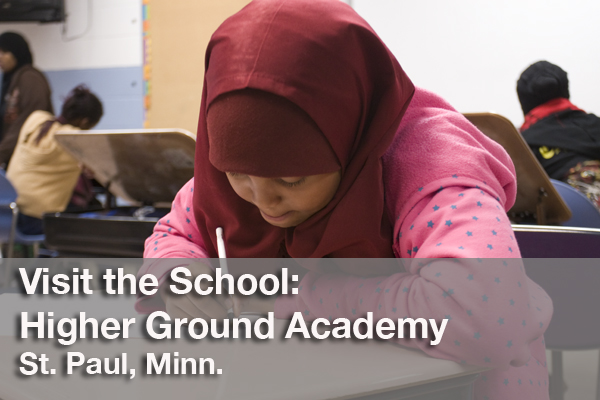
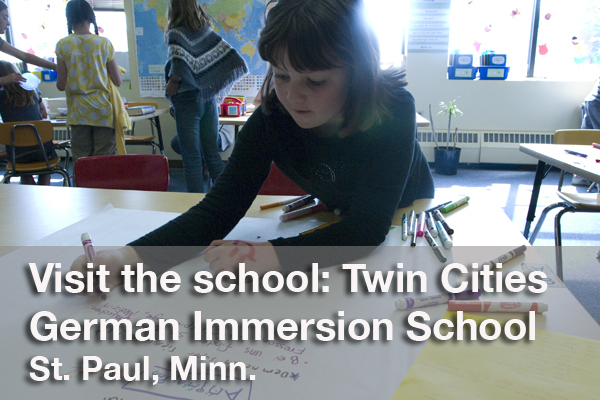
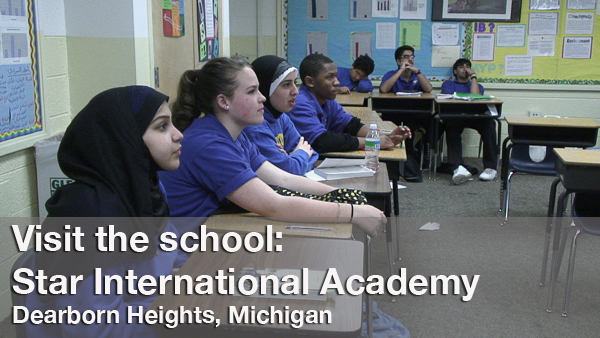
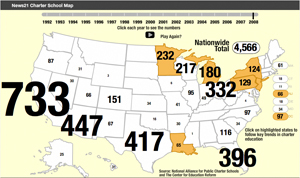










Hrmm that was weird, my comment got eaten. Anyway I wanted to say that it’s nice to know that someone else also mentioned this as I had trouble finding the same info elsewhere. Thanks.中国历史
Hrmm that was weird, my comment got eaten. Anyway I wanted to say that it’s nice to know that someone else also mentioned this as I had trouble finding the same info elsewhere. Thanks.
ОТЛИЧНО РАБОТАЕТ!!!!!! СпаСИБО
Sign: zbdtg Hello!!! cxvsr and 3414tnyeydsuah and 8941 : I love your site. Love design!!! I just came across your blog and wanted to say that Ive really enjoyed browsing your blog posts.
Love design!!! I just came across your blog and wanted to say that Ive really enjoyed browsing your blog posts.
Sign: pxyvz Hello!!! ybfyu and 707eazcuygvph and 9242 My Comments: Cool!
Sign: umsun Hello!!! rcuwwymhyw and 1522ssgfhphzye and 3197Thanks. We look forward to hearing from you again and for your opinions on the world of work.
I love your site. Love design!!! I just came across your blog and wanted to say that I
Love design!!! I just came across your blog and wanted to say that I
I love your site. Love design!!! I just came across your blog and wanted to say that I
Love design!!! I just came across your blog and wanted to say that I
Hi! I was surfing and found your blog post… nice! I love your blog. Cheers! Sandra. R.
Cheers! Sandra. R.
A truly fascinating article. It is amazing to watch the charter school expansion and the tendencies of those who are attending them. The school that you focused on seemed to be portrayed as one that had an unusually large number of new immigrants. It appears that historically influxes of new immigrants tend to form their own communities in order to keep some form of familiarity amidst the challenges of assimilation. I wonder whether the same things occur amongst 3rd or 4th generation Americans. If so, what influences their decisions?
Hey,
Great read. I am an aspiring journalist unlike an established one like you. I am from India which is one unique experiment in democracy wherein the diverse races, caste, class and ehinicity divide has not been able to shake its foundations. Such school environment narrows down a child’s growth process as he is not exposed to other multi-cultural mores and ethos. It does not promote a healthy respect and tolerence for cultural diference which should be fostered right from ones childhood.
Take care
from an aspirant of J-School
Jayoti Soor